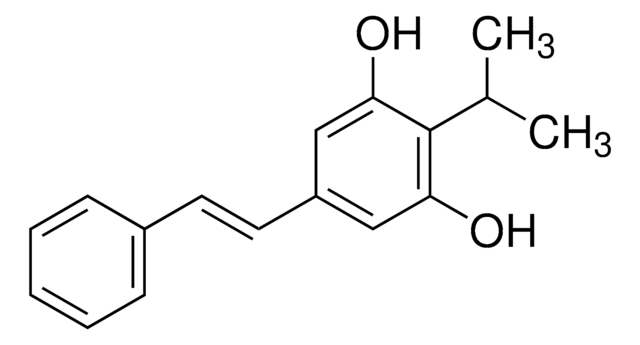추천 제품
Grade
analytical standard
CofA
current certificate can be downloaded
포장
ampule of 1 mL
저장 온도
2-8°C
InChI
1S/C12H4Cl4O2/c13-5-1-9-10(2-6(5)14)18-12-4-8(16)7(15)3-11(12)17-9/h1-4H
InChI key
HGUFODBRKLSHSI-UHFFFAOYSA-N
일반 설명
2,3,7,8-Tetrachlorodibenzo-p-dioxin is a highly distributed environmental contaminant, released by industrial activities, which can act like as a reproductive toxicant and endocrine disruptor in all vertebrates.
2,3,7,8-Tetrachlorodibenzo-p-dioxin is the most potent congener of dioxins and dioxin-like chemicals, which can exert adverse effects in laboratory animals used in testing.
애플리케이션
2,3,7,8-Tetrachlorodibenzo-p-dioxin solution has been used as standard in investigating the effect of 2,3,7,8-Tetrachlorodibenzo-p-dioxin to offsprings of fish, using high performance gas chromatography coupled with high performance mass spectrometry (HPGC-HPMS).
Refer to the product′s Certificate of Analysis for more information on a suitable instrument technique. Contact Technical Service for further support.
신호어
Danger
유해 및 위험 성명서
Hazard Classifications
Aquatic Chronic 1 - Asp. Tox. 1 - Flam. Liq. 2 - Repr. 2 - Skin Irrit. 2 - STOT RE 2 - STOT SE 3
표적 기관
Central nervous system
Storage Class Code
3 - Flammable liquids
WGK
WGK 3
Flash Point (°F)
39.2 °F - closed cup
Flash Point (°C)
4 °C - closed cup
Filomena Fiorito et al.
Toxicology, 290(2-3), 258-270 (2011-10-22)
The administration of 2,3,7,8-tetrachlorodibenzo-p-dioxin (TCDD) to a variety of cultured cells may alter their ability to proliferate and die. In a previous study we demonstrated that TCDD induced proliferation in Madin-Darby Bovine Kidney (MDBK) cells where no signs of apoptosis
E C Rada et al.
Chemosphere, 110, 53-61 (2014-06-02)
Atmospheric depositions of polychlorinated dibenzo-p-dioxins and dibenzofurans (PCDD/Fs) and polychlorinated biphenyls (PCBs) were monitored at three sites in the vicinity of a steel making plant, located in an Italian alpine valley. A high variability in the deposition of PCDD/Fs was
K A Solak et al.
Toxicology, 311(3), 124-134 (2013-07-23)
The aryl hydrocarbon receptor (AhR) is involved in a wide variety of biological and toxicological responses, including neuroendocrine signaling. Due to the complexity of neuroendocrine pathways in e.g. the hypothalamus and pituitary, there are limited in vitro models available despite
Maria Herlin et al.
Toxicology and applied pharmacology, 273(1), 219-226 (2013-09-17)
Bone is a target for high affinity aryl hydrocarbon receptor (AHR) ligands, such as dioxins. Although bone morphology, mineral density and strength are sensitive endpoints of dioxin toxicity, less is known about effects on bone microarchitecture and material properties. This
Hongtao Shang et al.
Environment international, 54, 50-58 (2013-02-19)
A total of 60 paired samples of earthworm, corresponding soil and wormcast were collected to investigate the bioaccumulation tendency of polychlorinated dibenzo-p-dioxins/dibenzofurans (PCDD/Fs), polychlorinated biphenyls (PCBs) and polybrominated diphenyl ethers (PBDEs) in earthworms from a typical E-waste dismantling area in
자사의 과학자팀은 생명 과학, 재료 과학, 화학 합성, 크로마토그래피, 분석 및 기타 많은 영역을 포함한 모든 과학 분야에 경험이 있습니다..
고객지원팀으로 연락바랍니다.

![Benzo[a]pyrene ≥96% (HPLC)](/deepweb/assets/sigmaaldrich/product/structures/253/820/be96d879-1811-46c0-8f11-612019691c2d/640/be96d879-1811-46c0-8f11-612019691c2d.png)










